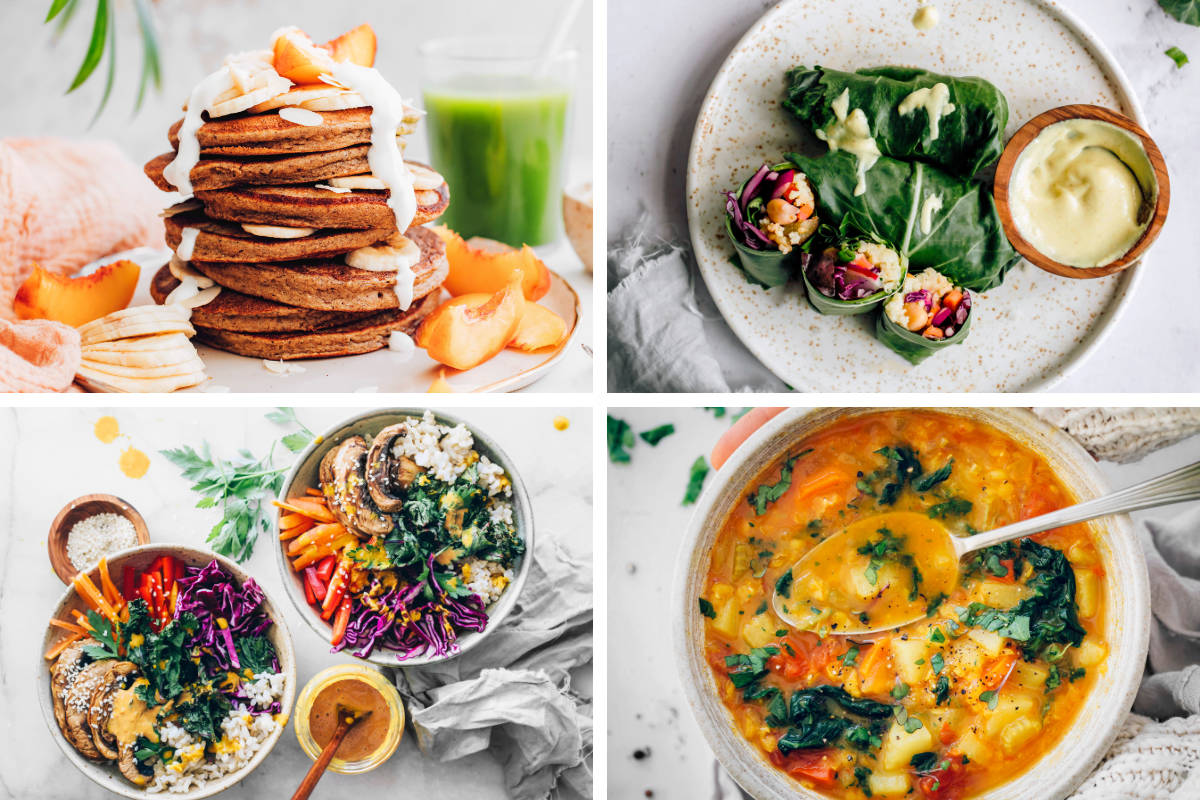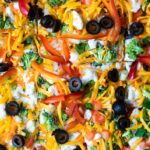Embark on a culinary adventure where delicious vegetarian cuisine meets the needs of those with food allergies. This guide unveils a world of flavorful, allergy-conscious recipes, transforming everyday meals into vibrant and safe culinary experiences. Discover ingenious substitutions that maintain taste and texture, allowing you to enjoy your favorite vegetarian dishes without compromise. From creamy dairy-free sauces to perfectly textured gluten-free lasagna, this resource is your key to unlocking a world of possibilities.
We’ll explore a range of popular vegetarian recipes, carefully adapted to eliminate common allergens like dairy, gluten, nuts, and soy. Learn practical techniques for modifying existing recipes and creating entirely new allergen-free dishes. Step-by-step guides, detailed ingredient lists, and stunning visuals will empower you to confidently prepare delicious and safe meals for yourself and your loved ones. We’ll also equip you with the knowledge to navigate food labels, restaurant menus, and kitchen practices to maintain a safe and enjoyable culinary journey.
Step-by-Step Guide to Creating Allergen-Friendly Vegetarian Meals

This guide provides detailed, step-by-step instructions for creating delicious and nutritious vegetarian meals that are free from common allergens. Each recipe focuses on specific allergen avoidance while maintaining vibrant flavors and textures. Careful ingredient selection is key to ensuring the safety and enjoyment of these dishes.
Gluten-Free and Dairy-Free Vegetarian Chili
This hearty chili is packed with flavor and is easily adaptable to individual preferences. The recipe avoids both gluten and dairy, making it suitable for many dietary needs.
Ingredients: 1 tbsp olive oil, 1 large onion (chopped), 2 cloves garlic (minced), 1 red bell pepper (chopped), 1 green bell pepper (chopped), 1 (28 ounce) can crushed tomatoes, 1 (15 ounce) can kidney beans (rinsed and drained), 1 (15 ounce) can black beans (rinsed and drained), 1 (15 ounce) can corn (drained), 1 tbsp chili powder, 1 tsp cumin, 1/2 tsp oregano, 1/4 tsp cayenne pepper (optional), salt and pepper to taste, gluten-free vegetable broth (as needed).
Instructions:
- Heat olive oil in a large pot over medium heat. Add onion and cook until softened, about 5 minutes.
- Stir in garlic and bell peppers; cook for another 3-5 minutes, until slightly tender.
- Add crushed tomatoes, kidney beans, black beans, corn, chili powder, cumin, oregano, and cayenne pepper (if using). Season with salt and pepper.
- Bring to a simmer, then reduce heat and cook for at least 30 minutes, or longer for a richer flavor. Stir occasionally and add gluten-free vegetable broth if needed to adjust consistency.
Nut-Free Vegan Lasagna
This lasagna avoids nuts entirely, making it a safe and satisfying option for those with nut allergies. The layers of vibrant vegetables and flavorful sauce create a visually appealing and delicious meal.
Ingredients: Lasagna noodles (gluten-free and egg-free), 1 tbsp olive oil, 1 large onion (chopped), 2 cloves garlic (minced), 1 zucchini (sliced), 1 yellow squash (sliced), 1 eggplant (sliced), 1 red bell pepper (sliced), 1 (28 ounce) can crushed tomatoes, 1 tsp dried oregano, 1 tsp dried basil, salt and pepper to taste, 1 (15 ounce) can lentils (rinsed and drained), vegan ricotta cheese (nut-free).
Instructions:
- Sauté Vegetables: Heat olive oil in a large skillet over medium heat. Add onion and cook until softened. Add garlic, zucchini, squash, eggplant, and bell pepper. Cook until slightly tender, about 8-10 minutes. Imagine the vibrant colors of the vegetables as they soften, creating a beautiful medley of textures and hues.
- Prepare the Sauce: In a separate saucepan, combine crushed tomatoes, oregano, basil, salt, and pepper. Simmer for 15 minutes, allowing the flavors to meld and deepen. The aroma will fill your kitchen with the scent of simmering tomatoes and herbs.
- Layer the Lasagna: Spread a thin layer of tomato sauce in the bottom of a 9×13 inch baking dish. Layer with lasagna noodles, followed by a layer of the sautéed vegetables. Spread a layer of vegan ricotta cheese evenly over the vegetables. Repeat layers until all ingredients are used, ending with a layer of sauce and a sprinkle of vegan parmesan cheese (nut-free).
- Bake: Cover the lasagna with foil and bake in a preheated oven at 375°F (190°C) for 30 minutes. Remove the foil and bake for another 15-20 minutes, until bubbly and heated through. The top will develop a slight golden brown color, and the aroma of baked vegetables and cheese will be enticing.
Soy-Free and Allergen-Aware Vegetarian Stir-Fry
This stir-fry emphasizes careful ingredient selection to avoid soy and other common allergens. The focus is on fresh, vibrant vegetables and a flavorful sauce that’s both allergy-friendly and delicious.
Ingredients: 1 tbsp coconut aminos (or tamari if soy is tolerated), 1 tbsp rice vinegar, 1 tbsp sesame oil, 1 tsp grated ginger, 1 clove garlic (minced), 1 red bell pepper (sliced), 1 broccoli head (cut into florets), 1 cup snow peas, 1 cup sliced mushrooms, 1/2 cup cooked quinoa or brown rice.
Instructions:
- Prepare the Sauce: In a small bowl, whisk together coconut aminos, rice vinegar, sesame oil, ginger, and garlic. The sauce should have a slightly sweet and tangy aroma, combining the savory notes of coconut aminos with the bright acidity of rice vinegar.
- Stir-Fry the Vegetables: Heat a wok or large skillet over high heat. Add the bell pepper, broccoli, snow peas, and mushrooms. Stir-fry for 3-5 minutes, until the vegetables are crisp-tender. The vegetables should retain their bright colors and a slight crunch.
- Combine and Serve: Pour the sauce over the vegetables and toss to coat. Stir in the cooked quinoa or brown rice. Serve immediately. The finished stir-fry will be a vibrant mix of colors and textures, with a flavorful and balanced sauce.
Vegetarian Recipe Resources for People with Food Allergies
Finding delicious and safe vegetarian meals can be a challenge when managing food allergies. Fortunately, numerous resources exist to guide individuals through creating flavorful and allergy-conscious vegetarian dishes. This section highlights key resources and provides practical advice for navigating dining out and ordering food online.
Reputable Online Resources and Cookbooks
Access to reliable information is crucial for individuals with food allergies. The following resources offer a curated selection of vegetarian recipes designed with allergy considerations in mind. Each resource provides a unique focus, ensuring a diverse range of options to meet various dietary needs.
- The Allergy-Free Kitchen: This resource (imagine a website with vibrant images of colorful, allergy-friendly vegetarian dishes) specializes in recipes free from common allergens like dairy, gluten, soy, nuts, and eggs. It offers detailed ingredient lists, clear instructions, and often includes substitution suggestions for accommodating various allergies. The website’s design is clean and easy to navigate, with a strong emphasis on visually appealing food photography.
- Allergy-Friendly Vegetarian Cookbook (imagine a cookbook cover featuring a lush green salad with colorful vegetables): This cookbook (imagine a cookbook with a clean, modern design and high-quality photographs) focuses on providing a wide variety of vegetarian recipes, each meticulously crafted to be free from specific allergens. Recipes are categorized by allergy type (e.g., dairy-free, gluten-free, nut-free), making it easy to find suitable options. The detailed nutritional information provided further enhances its value.
- GoDairyFree.org: While not exclusively vegetarian, this extensive website (imagine a website with a calming color scheme and well-organized content) offers a wealth of dairy-free recipes, many of which are vegetarian. It includes detailed articles on managing dairy allergies, alongside a large database of recipes categorized by dietary restrictions and ingredients. The website features user reviews and ratings, providing valuable feedback from other users.
- The Gluten-Free Goddess (imagine a website featuring a banner image of a healthy, gluten-free vegetarian meal): This resource (imagine a website with a focus on vibrant imagery and clear recipe instructions) offers a collection of gluten-free vegetarian recipes. While not specifically focused on all allergies, it provides many options suitable for those avoiding gluten, often including notes on easily adapting recipes to eliminate other allergens.
- EatingWell Magazine (imagine a magazine cover showcasing a variety of healthy vegetarian dishes): While not solely dedicated to allergy-free cooking, EatingWell consistently publishes vegetarian recipes with options for modifying them to accommodate common allergies. Their online presence and magazine offer detailed instructions, beautiful photography, and often include nutritional information. The emphasis on wholesome ingredients and adaptable recipes makes it a valuable resource.
Safely Navigating Restaurant Menus and Ordering Vegetarian Dishes
Careful planning is essential when dining out. Before visiting a restaurant, checking the menu online to identify potentially problematic ingredients can save time and prevent unpleasant surprises. When ordering, clearly state your allergies to the server and inquire about preparation methods to ensure cross-contamination is avoided. For example, if you have a soy allergy, you might ask, “Is this dish prepared in a separate area from dishes containing soy sauce?”
Communicating Dietary Needs and Allergies When Dining Out or Ordering Food Online
Clear and concise communication is paramount. When ordering food online or at a restaurant, explicitly state your allergies, emphasizing the severity if necessary. For instance, instead of saying “I’m allergic to nuts,” you could say, “I have a severe nut allergy; even trace amounts can cause a serious reaction.” Repeating your allergies to confirm understanding is always a good practice. Carrying a card or using a food allergy app that clearly lists your allergies can also be helpful.
Understanding Food Labels and Allergen Identification
Navigating the grocery store can be a minefield for individuals with food allergies. Understanding food labels is paramount to ensuring safety and avoiding potentially life-threatening reactions. This section details how to effectively decipher food labels, understand allergen labeling regulations, and implement practical kitchen strategies to minimize cross-contamination risks.
Food labels provide crucial information about a product’s ingredients, nutritional content, and potential allergens. The ingredient list, usually found near the top of the label, is the most important section for those with allergies. Ingredients are listed in descending order by weight, meaning the ingredient present in the largest quantity is listed first. Carefully scrutinize this list for any potential allergens you need to avoid. Pay close attention to common allergen names and their synonyms, as manufacturers may use different terms. For example, “whey” is a milk derivative.
Ingredient Lists and Allergen Declaration
The ingredient list is your primary defense against accidental allergen exposure. Manufacturers are legally required to clearly list all major allergens in a prominent way, often in bold or a different font color. Common allergens such as milk, eggs, peanuts, tree nuts, soy, wheat, fish, and shellfish must be declared. However, it’s vital to remember that even small amounts of an allergen can trigger a reaction in sensitive individuals. Don’t rely solely on the absence of a specific allergen name; be aware that cross-contamination during manufacturing is possible, and check for relevant warnings. Imagine a vibrant image of a food label: the ingredient list stands out, with “peanuts” clearly highlighted in bold red lettering. Below that, a smaller print states, “Manufactured in a facility that also processes peanuts and tree nuts.” This visual emphasizes the importance of reading both the ingredient list and any cross-contamination warnings.
Common Allergen Labeling Regulations and Implications
Many countries have specific regulations regarding allergen labeling. These regulations generally require that allergens are clearly identified on the label. However, regulations vary slightly between countries. For example, the EU has strict labeling regulations that require a clear statement of all 14 major allergens, while the US has similar requirements but with some differences in how these are presented. The implications for consumers are significant: clear labeling allows individuals with food allergies to make informed choices and avoid potentially harmful products. Failure to comply with these regulations can lead to serious health consequences and legal repercussions for manufacturers.
Managing Food Allergies in the Kitchen: Cross-Contamination Prevention
Preventing cross-contamination is crucial for individuals with food allergies. This involves careful storage, preparation, and cleaning techniques. Designated cutting boards, utensils, and cooking surfaces should be used for allergen-free foods. Thorough cleaning with hot, soapy water is essential after preparing foods containing allergens. Consider using separate containers for storing allergen-free and allergen-containing foods to avoid accidental mixing. A vivid mental picture might depict a kitchen with clearly labeled containers: one labeled “Gluten-Free,” another labeled “Peanut-Free,” each with different colored lids to distinguish them at a glance. This illustrates the importance of visual cues to maintain separation and prevent accidental cross-contamination.
Creating delicious and safe vegetarian meals for those with food allergies doesn’t have to be daunting. With careful planning, creative substitutions, and a deep understanding of allergen identification, you can enjoy a wide variety of flavorful and satisfying dishes. This guide has provided the tools and resources to empower you to take control of your culinary experience, ensuring every bite is both delicious and safe. Embrace the vibrant world of allergen-free vegetarian cooking and savor the journey!
Popular Questions
Can I freeze adapted vegetarian recipes?
Yes, many adapted vegetarian recipes freeze well. Consider freezing portions individually for easy reheating. Always label and date your containers.
What are some good resources for finding certified allergen-free ingredients?
Look for brands that clearly label their products as allergen-free and are certified by reputable organizations. Check online retailers specializing in allergy-friendly foods.
How can I avoid cross-contamination when cooking for someone with allergies?
Use separate cutting boards, utensils, and cooking surfaces for allergen-free dishes. Thoroughly wash and sanitize all equipment after use. Be mindful of airborne allergens when cooking.
Are all commercially available gluten-free products safe for those with celiac disease?
Not necessarily. Always check the label for potential cross-contamination warnings and ensure the product is specifically certified gluten-free by a recognized organization.


